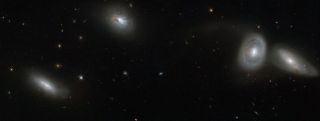Hubble Telescope Captures 'Bizarre Cosmic Quartet' of Galaxies

Talk about galactic drama. Some of the strangest galaxies in the universe congregate in groups like this motley crew, where the Hubble Space Telescope has found examples of furious star creation, bright radiation and active supermassive black holes.
In the new Hubble view, a quirky band of galaxies called HCG 16 take center stage, and we gave them a rock-and-roll video treatment set to the song "Blast the Message" by the band Super 400. Hubble mission representatives described the galactic arrangement as a "bizarre cosmic quartet" in an image description.
Of the four galaxies pictured in the close-up image, the leftmost has heated gas at its core that blasts out infrared radiation, and its neighbor furiously creates new stars — it's a starburst galaxy — and lacks a monster black hole at its center. The two galaxies to the right each harbor huge, active black holes at their cores and shine brightly in nonvisible wavelengths. The rightmost is so bright with X-rays that it's likely its gas and dust were ripped away by other galaxies' close encounters.
That galaxy "is not alone in having a violent history — the morphology of NGC 839 (far left) is likely due to a galactic merger in the recent past, and long tails of glowing gas can be seen stretching away from the galaxies on the right of the image," according to a photo description by the European Space Agency.

The photo combined observations from Hubble's Wide Field Planetary Camera 2 with data from the European Southern Observatory's New Technology Telescope in Chile.
For more information on the music of Super 400 used by Space.com in the new video, visit: http://www.facebook.com/super400.
Email Sarah Lewin at slewin@space.com or follow her @SarahExplains. Follow us @Spacedotcom, Facebook and Google+. Original article on Space.com.
Get the Space.com Newsletter
Breaking space news, the latest updates on rocket launches, skywatching events and more!
Join our Space Forums to keep talking space on the latest missions, night sky and more! And if you have a news tip, correction or comment, let us know at: community@space.com.

Sarah Lewin started writing for Space.com in June of 2015 as a Staff Writer and became Associate Editor in 2019 . Her work has been featured by Scientific American, IEEE Spectrum, Quanta Magazine, Wired, The Scientist, Science Friday and WGBH's Inside NOVA. Sarah has an MA from NYU's Science, Health and Environmental Reporting Program and an AB in mathematics from Brown University. When not writing, reading or thinking about space, Sarah enjoys musical theatre and mathematical papercraft. She is currently Assistant News Editor at Scientific American. You can follow her on Twitter @SarahExplains.
